Medium Bees 1/2″ “jelly bean”
Leafcutter Bees genus Megachile
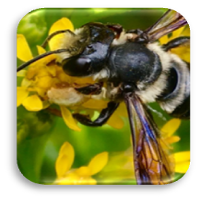
Male Carpenter Mimic Leafcutter Bee
Megachile xylocopoides
Size: 1/2″ medium
Season: Mar – Nov
Description: A very dark body resembling a carpenter bee, especially the bluish-purple Southern Carpenter Bee. Males have large “love mitts” on their front legs, which the male uses to cover the eyes of the female during mating.
Houston is home to 13 species of Leafcutters, or Megachilidae. Megachile means “big-lipped family.”
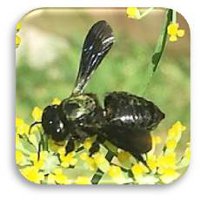
Female Carpenter Mimic Leafcutter Bee
Megachile xylocopoides
Size: 1/2″ medium
Season: Mar – Nov
Description: A very dark body resembling a carpenter bee, especially the bluish-purple Southern Carpenter Bee.
Cavity-dwelling Megachilids live in wood tunnels or other preconstructed holes. With their enormous mandibles (jaws) and heavy-duty teeth, they snip small circles from leaves to use in their nests as wallpaper.
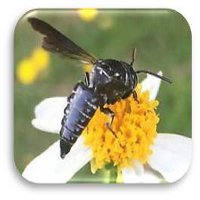
Cuckoo Leafcutter Bee
Genus Coelioxys
Coelioxys is Greek for “sharp-belly” because the abdomen is cone-shaped and pointed, ending in spines in males.
Size: 1/2″ medium
Season: June – Sept
Description: Cuckoo Leafcutter bees are cleptoparasitic (parasitism by theft), and parasitize other Leafcutter bees. They use their pointy abdomen to break a hole into nest walls and lay an egg inside; when it hatches, the baby cuckoo bee uses its sharp mandibles (jaws) to snip the host egg in half, and eat the food stored for it by the mother. There are no hairs since this bee does not collect pollen.
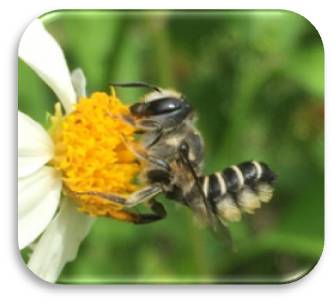
Leafcutter bee posture
The posture of leafcutter bees is very unique – they bend their abdomen upward when they are resting.
Leafcutters often prefer plants with antimicrobial chemicals such as rose plants.
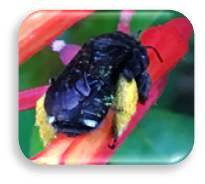
Two Spotted Long Horned Bee
Melissodes bimaculata
Season: May – Oct
Nesting: Ground-dwelling
Description: All black with two white spots near the tip of the abdomen.
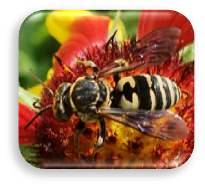
Cuckoo Bee
Genus Triepeolus
Season: May – Oct
Nesting: Cleptoparasitic on ground-dwelling bees
Description: Striking black and white bands, most have a signature “smiley face” on the back of their thorax.
Honey Bees
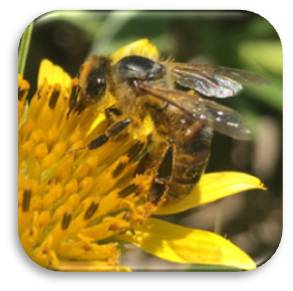
Western Honey Bee
Apis mellifera the genus name Apis is Latin for “bee”
Season: Year-Round
Nesting: Social, lives in hives which it protects, and which is why it will sting. It is the ONLY bee whose stinger comes loose when they sting.
Description: Honey bees have brown and black stripes on their abdomen; the abdomen tapers towards the thorax, and hair covers eyes like long lashes. Unlike other bees, honey bees often dangle their legs down as they fly. Cultivated since the time of the Egyptian pyramids, honey bees are not native to the western hemisphere and were brought by colonists to produce honey and wax. Of the approx. 20,000 species of bees recognized, only eight species of honey bee are recognized, with 43 subspecies. Additional info on our FAQ page, “Honey bees in Texas” and “Got a bee swarm?”
Native vs honey bee: which is the better pollinator?
![]() Native bees pollinate at 91% efficiency; non-native honey bees pollinate at 72% efficiency. (Winfree et al, 2007)
Native bees pollinate at 91% efficiency; non-native honey bees pollinate at 72% efficiency. (Winfree et al, 2007)
![]() Native bees are active for more hours of the day and during bad weather. (Winfree et al, 2007)
Native bees are active for more hours of the day and during bad weather. (Winfree et al, 2007)
![]() Native bees are not fussy pollinators, and can exist on general flora diet. (Mader et al, 2010)
Native bees are not fussy pollinators, and can exist on general flora diet. (Mader et al, 2010)
![]() Native bees have more stable populations; chemicals used to keep honey bee populations alive weaken their immune systems.
Native bees have more stable populations; chemicals used to keep honey bee populations alive weaken their immune systems.
![]() Native bees are safer around humans.
Native bees are safer around humans.
- Honey bees live in hives which they aggressively protect; this species evolved a poison sac and stinger which remains in the skin.
- Because native bees do not have hives to protect (90% are solitary, not social) they are much less likely to sting.
- Many native bees do not have a stinger that can penetrate human skin. (Shepherd, 2003)
- There are zero records of an allergic reaction to a native bee. (Droege, 2016)
“200 native bees can do the same level of pollination as a hive of honey bees containing over 10,000 workers.” Michael Warriner, Texas Parks & Wildlife, Native Bees in Texas
“The edge that honey bees have over native bees is that we can attach a dollar amount to honey bees’ ecosystem services for both honey and pollination. Having a hive makes them portable and quantifiable. Apiarists can charge a flat rate per hive and know how much area a hive can pollinate and roughly how much honey that will result in.” Danielle Bilot, 2016


